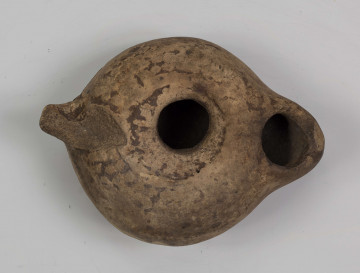
Candlestick
2. połowa XIX wieku
National Museum in Szczecin
Part of the collection: Pyrzycka folk culture
The candelabra (candle holder) for nine candles has a turned and moulded body supporting eight arms, arranged in two rows. Each arm is cut in the shape of a swan's neck, on which a bird's head turned backwards is supported, topped with a sleeve for setting the candle. The candelabra is a rare example of such beautiful lighting equipment from a rural environment. The different lengths of the arms and the red, green and yellow polychrome make it elegant in form and a fully elaborate decorative object. The history of lighting residential interiors had two landmark dates - 1853, when Ignacy Łukasiewicz constructed the first paraffin lamp, and 1882 when the first power plant began operation in New York. Until then, dwellings were illuminated by candles set in candlesticks by bows placed in candlesticks and by sticks filled with grease. The disappearance period of these simple lighting devices varied from region to region and country to country; in Poland, rural electrification officially ended in the 1960s. In the eighteenth century, the interiors of rural houses in West Pomerania were most often illuminated by arches set in hanging or standing candlesticks and then in the nineteenth century by oil lamps. In their dim and flickering light, all household chores were done, even embroidery and sewing. Wax candles have been known and used in the countryside for a long time, but they were lit mainly for cultic and magical purposes, during celebrations or when visiting an important guest. An affluent person from the wealthy Pyrzyce region could afford a unique nine-branched candle holder. Stearine candles were probably lit in it, which have been known since 1825. For the poorer inhabitants of Pomerania, for example, a small farmer or a fisherman from a village on the Baltic Sea, such candles were out of reach in the 19th century.
Iwona Karwowska
Author / creator
Dimensions
cały obiekt: height: 47 cm, width: 44 cm
Object type
lighting devices
Creation time / dating
Creation / finding place
Identification number
Location / status

2. połowa XIX wieku
National Museum in Szczecin

50 — 100
National Museum in Lublin

201 — 400
National Museum in Lublin
DISCOVER this TOPIC
Castle Museum in Łańcut
DISCOVER this PATH
Educational path